Leadership Style Evaluation: Project Lead Experience and Analysis
VerifiedAdded on 2020/02/19
|6
|1704
|73
Report
AI Summary
This report provides a reflective analysis of a project lead's leadership style within the context of a real-world project at the ABC organization. The author, acting as the project lead, explores the challenges encountered while implementing a democratic leadership style, emphasizing the importance of team member contributions in decision-making. The report details the author's experiences, including interpersonal skills, conflict resolution attempts, and the impact of these approaches on team dynamics and project outcomes. It assesses the strengths, weaknesses, opportunities, and threats associated with the leadership style, highlighting the need for improved emotional intelligence and tact in managing team conflicts. The report also incorporates feedback from a fellow project lead and considers the influence of organizational culture on leadership effectiveness. The author concludes by outlining a leadership development plan to address identified skill gaps and improve future performance.
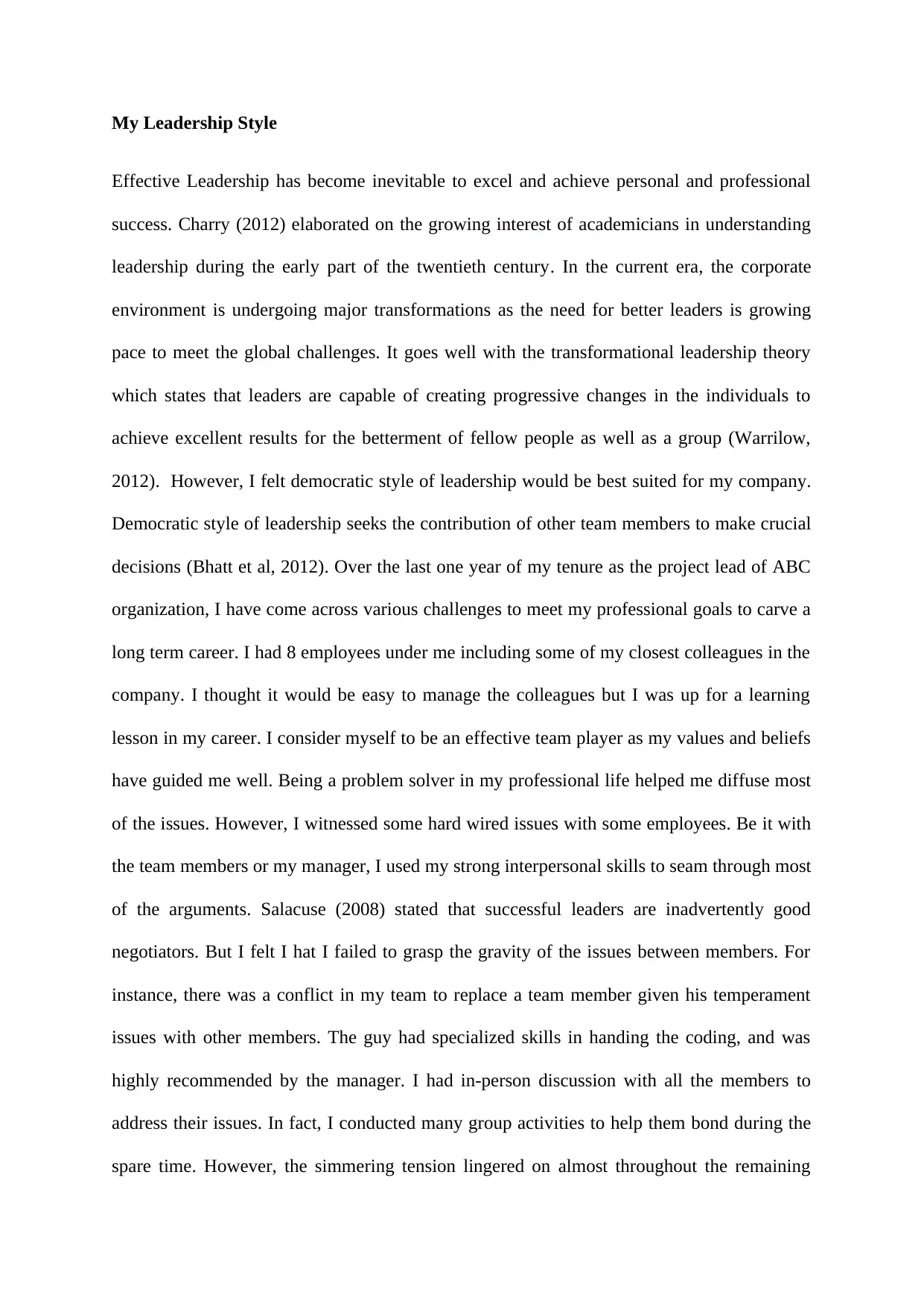
My Leadership Style
Effective Leadership has become inevitable to excel and achieve personal and professional
success. Charry (2012) elaborated on the growing interest of academicians in understanding
leadership during the early part of the twentieth century. In the current era, the corporate
environment is undergoing major transformations as the need for better leaders is growing
pace to meet the global challenges. It goes well with the transformational leadership theory
which states that leaders are capable of creating progressive changes in the individuals to
achieve excellent results for the betterment of fellow people as well as a group (Warrilow,
2012). However, I felt democratic style of leadership would be best suited for my company.
Democratic style of leadership seeks the contribution of other team members to make crucial
decisions (Bhatt et al, 2012). Over the last one year of my tenure as the project lead of ABC
organization, I have come across various challenges to meet my professional goals to carve a
long term career. I had 8 employees under me including some of my closest colleagues in the
company. I thought it would be easy to manage the colleagues but I was up for a learning
lesson in my career. I consider myself to be an effective team player as my values and beliefs
have guided me well. Being a problem solver in my professional life helped me diffuse most
of the issues. However, I witnessed some hard wired issues with some employees. Be it with
the team members or my manager, I used my strong interpersonal skills to seam through most
of the arguments. Salacuse (2008) stated that successful leaders are inadvertently good
negotiators. But I felt I hat I failed to grasp the gravity of the issues between members. For
instance, there was a conflict in my team to replace a team member given his temperament
issues with other members. The guy had specialized skills in handing the coding, and was
highly recommended by the manager. I had in-person discussion with all the members to
address their issues. In fact, I conducted many group activities to help them bond during the
spare time. However, the simmering tension lingered on almost throughout the remaining
Effective Leadership has become inevitable to excel and achieve personal and professional
success. Charry (2012) elaborated on the growing interest of academicians in understanding
leadership during the early part of the twentieth century. In the current era, the corporate
environment is undergoing major transformations as the need for better leaders is growing
pace to meet the global challenges. It goes well with the transformational leadership theory
which states that leaders are capable of creating progressive changes in the individuals to
achieve excellent results for the betterment of fellow people as well as a group (Warrilow,
2012). However, I felt democratic style of leadership would be best suited for my company.
Democratic style of leadership seeks the contribution of other team members to make crucial
decisions (Bhatt et al, 2012). Over the last one year of my tenure as the project lead of ABC
organization, I have come across various challenges to meet my professional goals to carve a
long term career. I had 8 employees under me including some of my closest colleagues in the
company. I thought it would be easy to manage the colleagues but I was up for a learning
lesson in my career. I consider myself to be an effective team player as my values and beliefs
have guided me well. Being a problem solver in my professional life helped me diffuse most
of the issues. However, I witnessed some hard wired issues with some employees. Be it with
the team members or my manager, I used my strong interpersonal skills to seam through most
of the arguments. Salacuse (2008) stated that successful leaders are inadvertently good
negotiators. But I felt I hat I failed to grasp the gravity of the issues between members. For
instance, there was a conflict in my team to replace a team member given his temperament
issues with other members. The guy had specialized skills in handing the coding, and was
highly recommended by the manager. I had in-person discussion with all the members to
address their issues. In fact, I conducted many group activities to help them bond during the
spare time. However, the simmering tension lingered on almost throughout the remaining
Paraphrase This Document
Need a fresh take? Get an instant paraphrase of this document with our AI Paraphraser
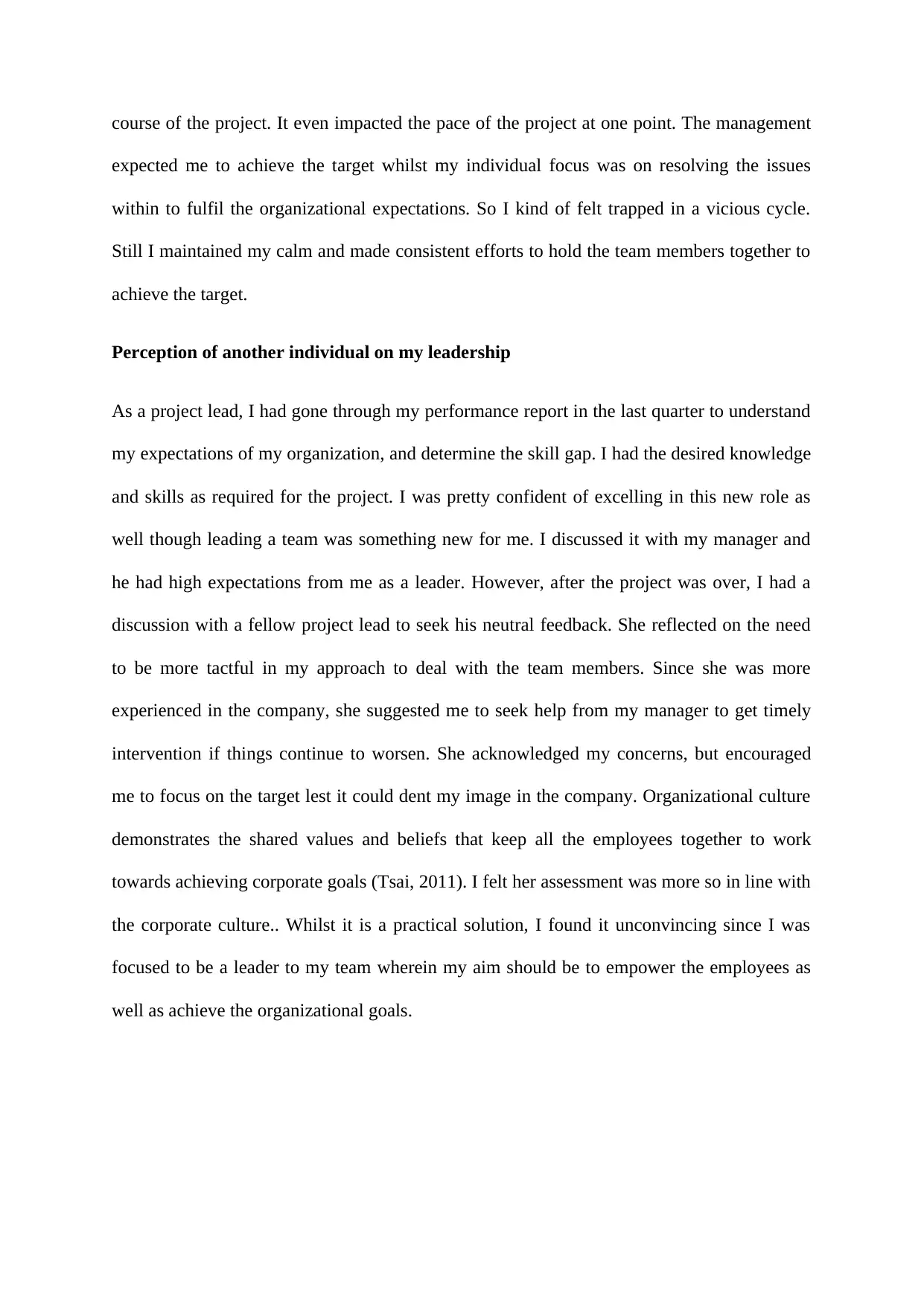
course of the project. It even impacted the pace of the project at one point. The management
expected me to achieve the target whilst my individual focus was on resolving the issues
within to fulfil the organizational expectations. So I kind of felt trapped in a vicious cycle.
Still I maintained my calm and made consistent efforts to hold the team members together to
achieve the target.
Perception of another individual on my leadership
As a project lead, I had gone through my performance report in the last quarter to understand
my expectations of my organization, and determine the skill gap. I had the desired knowledge
and skills as required for the project. I was pretty confident of excelling in this new role as
well though leading a team was something new for me. I discussed it with my manager and
he had high expectations from me as a leader. However, after the project was over, I had a
discussion with a fellow project lead to seek his neutral feedback. She reflected on the need
to be more tactful in my approach to deal with the team members. Since she was more
experienced in the company, she suggested me to seek help from my manager to get timely
intervention if things continue to worsen. She acknowledged my concerns, but encouraged
me to focus on the target lest it could dent my image in the company. Organizational culture
demonstrates the shared values and beliefs that keep all the employees together to work
towards achieving corporate goals (Tsai, 2011). I felt her assessment was more so in line with
the corporate culture.. Whilst it is a practical solution, I found it unconvincing since I was
focused to be a leader to my team wherein my aim should be to empower the employees as
well as achieve the organizational goals.
expected me to achieve the target whilst my individual focus was on resolving the issues
within to fulfil the organizational expectations. So I kind of felt trapped in a vicious cycle.
Still I maintained my calm and made consistent efforts to hold the team members together to
achieve the target.
Perception of another individual on my leadership
As a project lead, I had gone through my performance report in the last quarter to understand
my expectations of my organization, and determine the skill gap. I had the desired knowledge
and skills as required for the project. I was pretty confident of excelling in this new role as
well though leading a team was something new for me. I discussed it with my manager and
he had high expectations from me as a leader. However, after the project was over, I had a
discussion with a fellow project lead to seek his neutral feedback. She reflected on the need
to be more tactful in my approach to deal with the team members. Since she was more
experienced in the company, she suggested me to seek help from my manager to get timely
intervention if things continue to worsen. She acknowledged my concerns, but encouraged
me to focus on the target lest it could dent my image in the company. Organizational culture
demonstrates the shared values and beliefs that keep all the employees together to work
towards achieving corporate goals (Tsai, 2011). I felt her assessment was more so in line with
the corporate culture.. Whilst it is a practical solution, I found it unconvincing since I was
focused to be a leader to my team wherein my aim should be to empower the employees as
well as achieve the organizational goals.
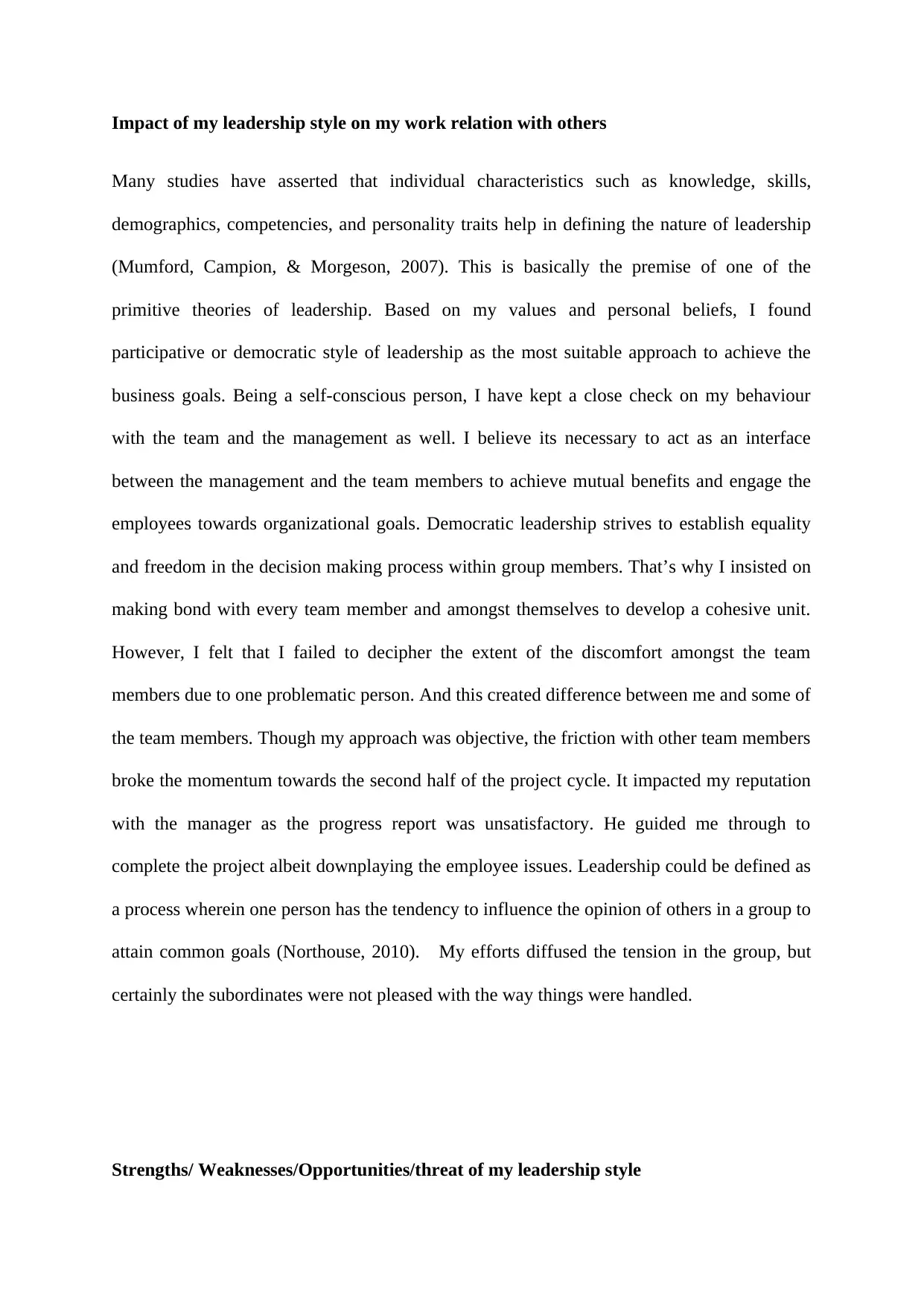
Impact of my leadership style on my work relation with others
Many studies have asserted that individual characteristics such as knowledge, skills,
demographics, competencies, and personality traits help in defining the nature of leadership
(Mumford, Campion, & Morgeson, 2007). This is basically the premise of one of the
primitive theories of leadership. Based on my values and personal beliefs, I found
participative or democratic style of leadership as the most suitable approach to achieve the
business goals. Being a self-conscious person, I have kept a close check on my behaviour
with the team and the management as well. I believe its necessary to act as an interface
between the management and the team members to achieve mutual benefits and engage the
employees towards organizational goals. Democratic leadership strives to establish equality
and freedom in the decision making process within group members. That’s why I insisted on
making bond with every team member and amongst themselves to develop a cohesive unit.
However, I felt that I failed to decipher the extent of the discomfort amongst the team
members due to one problematic person. And this created difference between me and some of
the team members. Though my approach was objective, the friction with other team members
broke the momentum towards the second half of the project cycle. It impacted my reputation
with the manager as the progress report was unsatisfactory. He guided me through to
complete the project albeit downplaying the employee issues. Leadership could be defined as
a process wherein one person has the tendency to influence the opinion of others in a group to
attain common goals (Northouse, 2010). My efforts diffused the tension in the group, but
certainly the subordinates were not pleased with the way things were handled.
Strengths/ Weaknesses/Opportunities/threat of my leadership style
Many studies have asserted that individual characteristics such as knowledge, skills,
demographics, competencies, and personality traits help in defining the nature of leadership
(Mumford, Campion, & Morgeson, 2007). This is basically the premise of one of the
primitive theories of leadership. Based on my values and personal beliefs, I found
participative or democratic style of leadership as the most suitable approach to achieve the
business goals. Being a self-conscious person, I have kept a close check on my behaviour
with the team and the management as well. I believe its necessary to act as an interface
between the management and the team members to achieve mutual benefits and engage the
employees towards organizational goals. Democratic leadership strives to establish equality
and freedom in the decision making process within group members. That’s why I insisted on
making bond with every team member and amongst themselves to develop a cohesive unit.
However, I felt that I failed to decipher the extent of the discomfort amongst the team
members due to one problematic person. And this created difference between me and some of
the team members. Though my approach was objective, the friction with other team members
broke the momentum towards the second half of the project cycle. It impacted my reputation
with the manager as the progress report was unsatisfactory. He guided me through to
complete the project albeit downplaying the employee issues. Leadership could be defined as
a process wherein one person has the tendency to influence the opinion of others in a group to
attain common goals (Northouse, 2010). My efforts diffused the tension in the group, but
certainly the subordinates were not pleased with the way things were handled.
Strengths/ Weaknesses/Opportunities/threat of my leadership style
⊘ This is a preview!⊘
Do you want full access?
Subscribe today to unlock all pages.

Trusted by 1+ million students worldwide
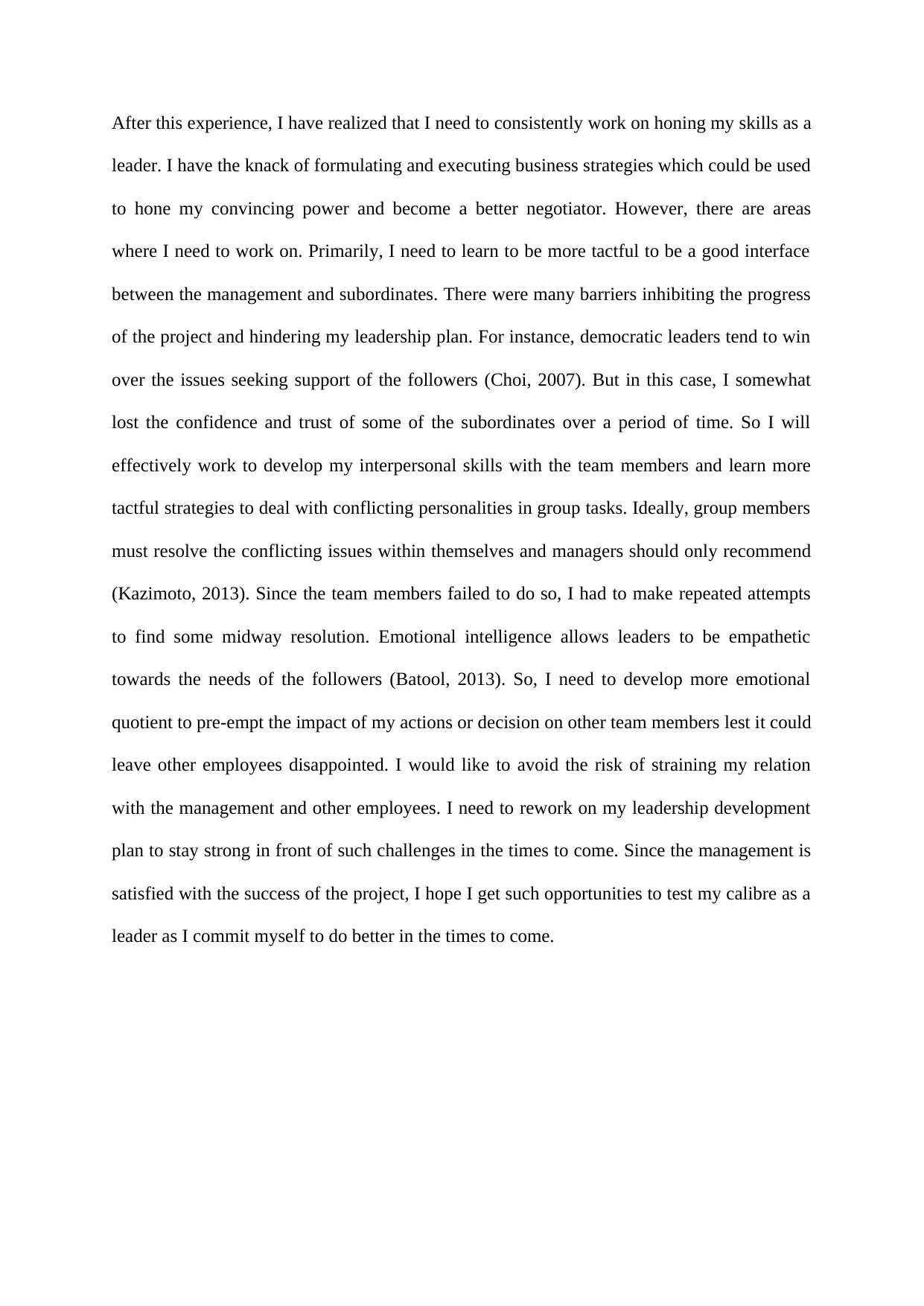
After this experience, I have realized that I need to consistently work on honing my skills as a
leader. I have the knack of formulating and executing business strategies which could be used
to hone my convincing power and become a better negotiator. However, there are areas
where I need to work on. Primarily, I need to learn to be more tactful to be a good interface
between the management and subordinates. There were many barriers inhibiting the progress
of the project and hindering my leadership plan. For instance, democratic leaders tend to win
over the issues seeking support of the followers (Choi, 2007). But in this case, I somewhat
lost the confidence and trust of some of the subordinates over a period of time. So I will
effectively work to develop my interpersonal skills with the team members and learn more
tactful strategies to deal with conflicting personalities in group tasks. Ideally, group members
must resolve the conflicting issues within themselves and managers should only recommend
(Kazimoto, 2013). Since the team members failed to do so, I had to make repeated attempts
to find some midway resolution. Emotional intelligence allows leaders to be empathetic
towards the needs of the followers (Batool, 2013). So, I need to develop more emotional
quotient to pre-empt the impact of my actions or decision on other team members lest it could
leave other employees disappointed. I would like to avoid the risk of straining my relation
with the management and other employees. I need to rework on my leadership development
plan to stay strong in front of such challenges in the times to come. Since the management is
satisfied with the success of the project, I hope I get such opportunities to test my calibre as a
leader as I commit myself to do better in the times to come.
leader. I have the knack of formulating and executing business strategies which could be used
to hone my convincing power and become a better negotiator. However, there are areas
where I need to work on. Primarily, I need to learn to be more tactful to be a good interface
between the management and subordinates. There were many barriers inhibiting the progress
of the project and hindering my leadership plan. For instance, democratic leaders tend to win
over the issues seeking support of the followers (Choi, 2007). But in this case, I somewhat
lost the confidence and trust of some of the subordinates over a period of time. So I will
effectively work to develop my interpersonal skills with the team members and learn more
tactful strategies to deal with conflicting personalities in group tasks. Ideally, group members
must resolve the conflicting issues within themselves and managers should only recommend
(Kazimoto, 2013). Since the team members failed to do so, I had to make repeated attempts
to find some midway resolution. Emotional intelligence allows leaders to be empathetic
towards the needs of the followers (Batool, 2013). So, I need to develop more emotional
quotient to pre-empt the impact of my actions or decision on other team members lest it could
leave other employees disappointed. I would like to avoid the risk of straining my relation
with the management and other employees. I need to rework on my leadership development
plan to stay strong in front of such challenges in the times to come. Since the management is
satisfied with the success of the project, I hope I get such opportunities to test my calibre as a
leader as I commit myself to do better in the times to come.
Paraphrase This Document
Need a fresh take? Get an instant paraphrase of this document with our AI Paraphraser
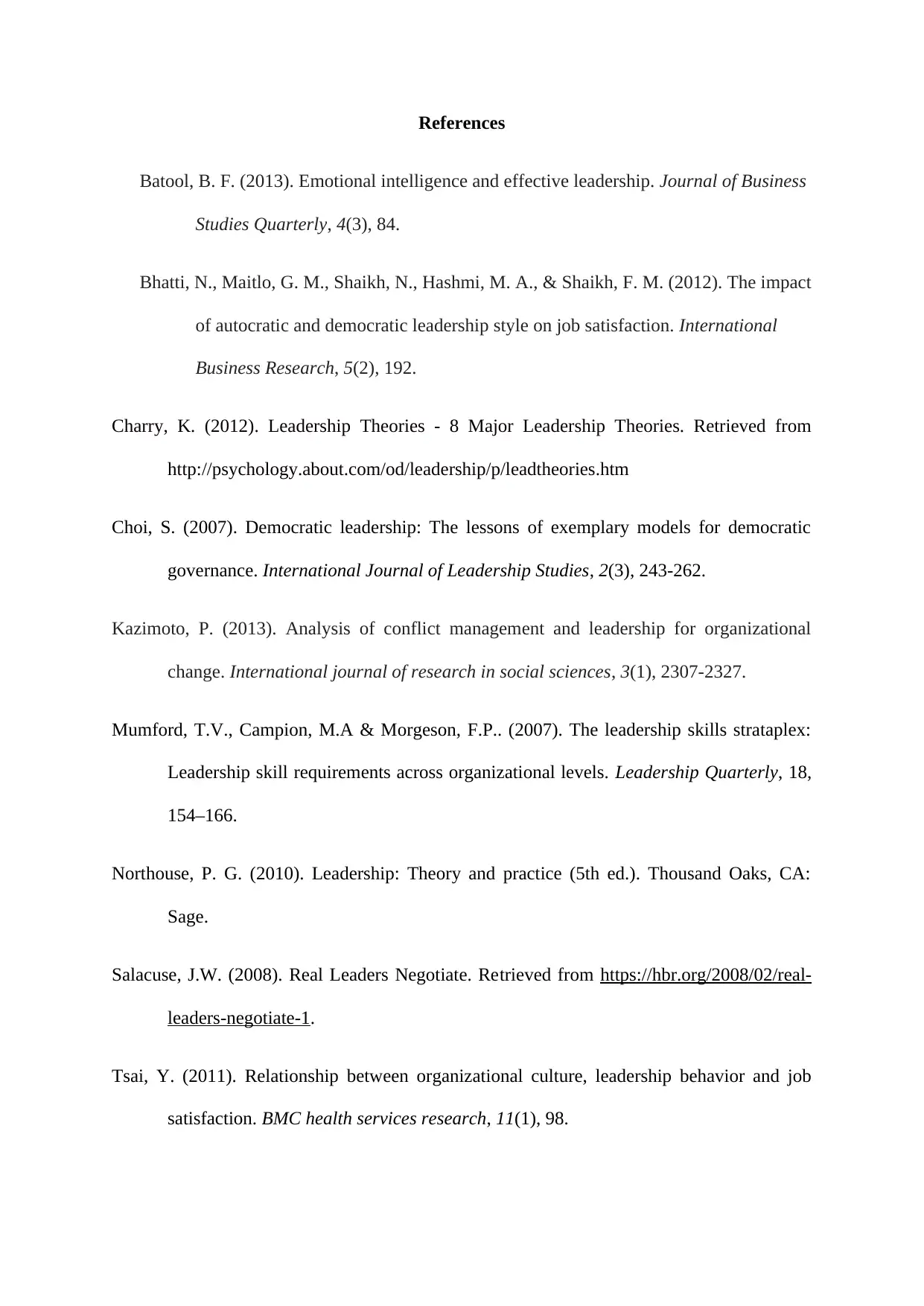
References
Batool, B. F. (2013). Emotional intelligence and effective leadership. Journal of Business
Studies Quarterly, 4(3), 84.
Bhatti, N., Maitlo, G. M., Shaikh, N., Hashmi, M. A., & Shaikh, F. M. (2012). The impact
of autocratic and democratic leadership style on job satisfaction. International
Business Research, 5(2), 192.
Charry, K. (2012). Leadership Theories - 8 Major Leadership Theories. Retrieved from
http://psychology.about.com/od/leadership/p/leadtheories.htm
Choi, S. (2007). Democratic leadership: The lessons of exemplary models for democratic
governance. International Journal of Leadership Studies, 2(3), 243-262.
Kazimoto, P. (2013). Analysis of conflict management and leadership for organizational
change. International journal of research in social sciences, 3(1), 2307-2327.
Mumford, T.V., Campion, M.A & Morgeson, F.P.. (2007). The leadership skills strataplex:
Leadership skill requirements across organizational levels. Leadership Quarterly, 18,
154–166.
Northouse, P. G. (2010). Leadership: Theory and practice (5th ed.). Thousand Oaks, CA:
Sage.
Salacuse, J.W. (2008). Real Leaders Negotiate. Retrieved from https://hbr.org/2008/02/real-
leaders-negotiate-1.
Tsai, Y. (2011). Relationship between organizational culture, leadership behavior and job
satisfaction. BMC health services research, 11(1), 98.
Batool, B. F. (2013). Emotional intelligence and effective leadership. Journal of Business
Studies Quarterly, 4(3), 84.
Bhatti, N., Maitlo, G. M., Shaikh, N., Hashmi, M. A., & Shaikh, F. M. (2012). The impact
of autocratic and democratic leadership style on job satisfaction. International
Business Research, 5(2), 192.
Charry, K. (2012). Leadership Theories - 8 Major Leadership Theories. Retrieved from
http://psychology.about.com/od/leadership/p/leadtheories.htm
Choi, S. (2007). Democratic leadership: The lessons of exemplary models for democratic
governance. International Journal of Leadership Studies, 2(3), 243-262.
Kazimoto, P. (2013). Analysis of conflict management and leadership for organizational
change. International journal of research in social sciences, 3(1), 2307-2327.
Mumford, T.V., Campion, M.A & Morgeson, F.P.. (2007). The leadership skills strataplex:
Leadership skill requirements across organizational levels. Leadership Quarterly, 18,
154–166.
Northouse, P. G. (2010). Leadership: Theory and practice (5th ed.). Thousand Oaks, CA:
Sage.
Salacuse, J.W. (2008). Real Leaders Negotiate. Retrieved from https://hbr.org/2008/02/real-
leaders-negotiate-1.
Tsai, Y. (2011). Relationship between organizational culture, leadership behavior and job
satisfaction. BMC health services research, 11(1), 98.
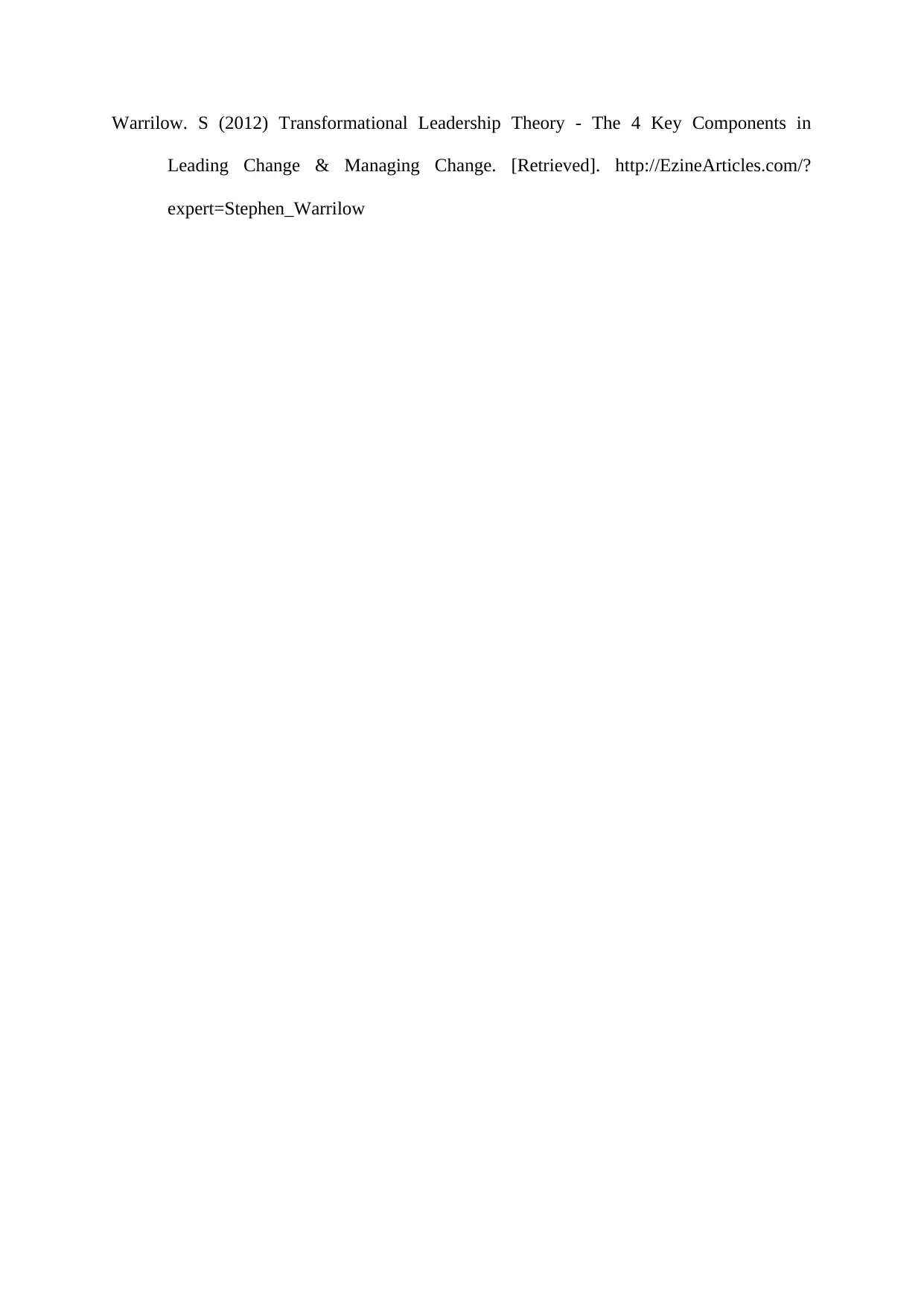
Warrilow. S (2012) Transformational Leadership Theory - The 4 Key Components in
Leading Change & Managing Change. [Retrieved]. http://EzineArticles.com/?
expert=Stephen_Warrilow
Leading Change & Managing Change. [Retrieved]. http://EzineArticles.com/?
expert=Stephen_Warrilow
⊘ This is a preview!⊘
Do you want full access?
Subscribe today to unlock all pages.

Trusted by 1+ million students worldwide
1 out of 6
Related Documents
Your All-in-One AI-Powered Toolkit for Academic Success.
+13062052269
info@desklib.com
Available 24*7 on WhatsApp / Email
![[object Object]](/_next/static/media/star-bottom.7253800d.svg)
Unlock your academic potential
Copyright © 2020–2025 A2Z Services. All Rights Reserved. Developed and managed by ZUCOL.





